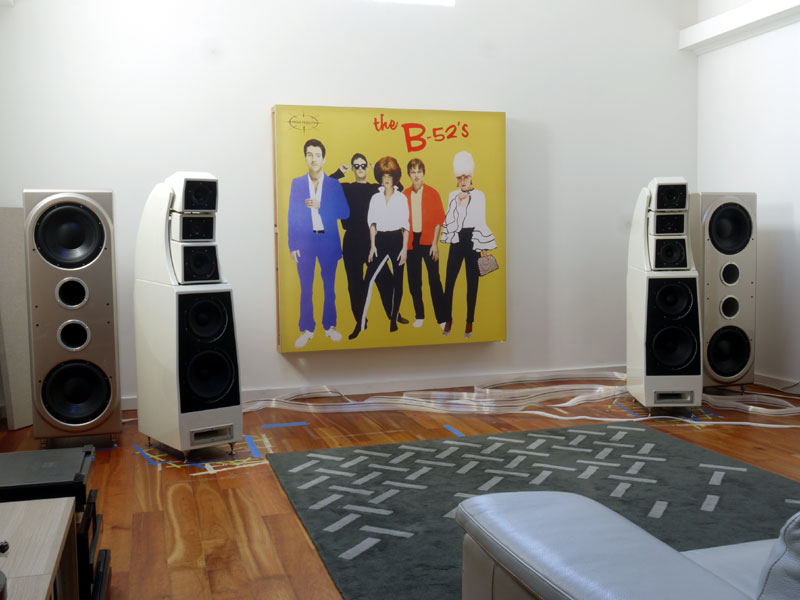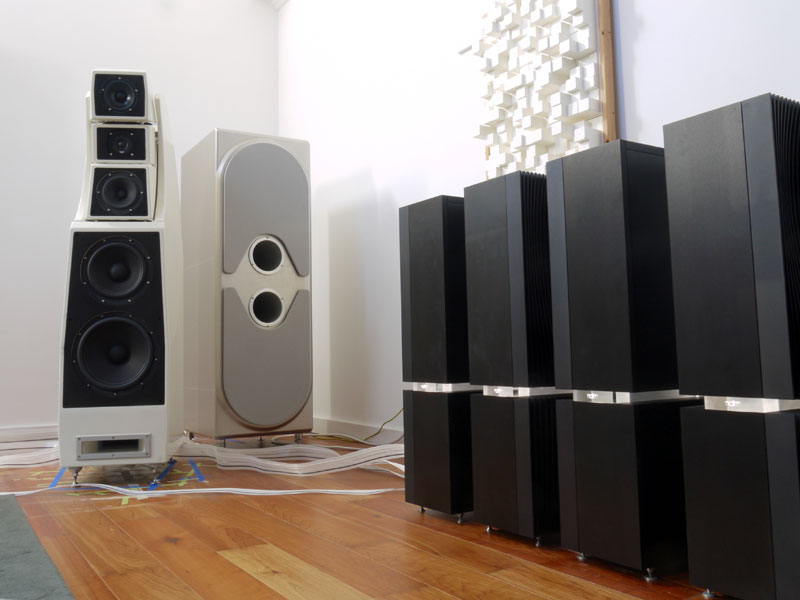First Sounds: Wilson Audio Alexx
The Alexx is a direct descendent of the MAXX, but is also much more than that. It shares the MAXX’s familiar large ported bass cabinet, with its differential low-frequency drive units. It also shares the pseudo-D’Appolito array mounted between its upper "cheeks" -- "pseudo" because that’s where the similarities stop and the differences begin. Outwardly similar to its predecessors, the Alexx is an altogether different and far more sophisticated beast, both mechanically and sonically. Not only does it use different (rather than paired) midrange drivers, each of the upper drive units enjoys its own independently adjustable cabinet. That makes for far more accurate time alignment and much more coherent propagation, as well as reduced intermodulation distortion. The bass cabinet retains the slot port of the earlier models, but now a machined trim and matching plug mean that the cabinet can vent forward or to the rear. Finally, the Alexx also benefits from the new cabinet materials that have slowly been infiltrating the range -- and contribute so effectively to the Sasha 2’s performance.
In combination, these factors make the Alexx a far more adaptable and configurable speaker, easier to match to and able to make greater use of different listening environments. It’s also significantly slimmer and more elegant in appearance than earlier Wilson designs. Indeed, of all the piled-up products (the X1, the various MAXX models and the Alexandrias) this is by far the most attractive, making it the easiest to accommodate in domestic terms too. Gone are the blocky shapes and muscular Darth Vader meets the Daleks styling, replaced by leaner, smoother, more flowing and organic lines. I wouldn’t go so far as to say that visitors have been brimming over with enthusiasm for the way the Alexx looks -- until I remind them of the MAXX 2. Then they get it. Speaking personally, having lived with the Alexx since the end of September, I’ve actually become very fond of the way this speaker looks -- and considerably fonder of the way it sounds. When Sasha 2 passed my way, I remarked that it wasn’t just the first WATT/Puppy iteration I’d reviewed, it was the first I’d wanted to review. It signaled a new sense of integration, rhythmic and dynamic coherence, greater timing integrity and musical clarity, both in terms of the notes themselves and the sense that binds them together. Combining those qualities with Wilson’s traditional strengths (wide dynamic range and bandwidth, and notable timbral resolution) made for a stellar musical performer, engaging and communicative, subtle and intimate when it needed to be, bold and dramatic when required. It was also inherently better balanced in terms of its overall virtues than previous WATT/Puppy iterations. The challenge for the Alexx was to build on and extend those capabilities, while confronting and overcoming the problems associated with larger cabinets and a far more complex crossover network. In order to appreciate just how successfully the new model has met that challenge, just play the smallest, most intimate recording you have: let’s use the Alia Vox disc Ninna Nanna [Alia Vox AV 9826]. A collection of lullabies from around the world and across the ages, it is perhaps the epitome of a gentle, intimate, acoustic recording. Track 8 is a traditional 18th-century song arranged for two voices (mezzo and soprano), guitar, flute, bells and bass viol. As gentle as it is, it’s also an amalgamation of some of the most recognizable and also demanding instrumental forces available, from flutes that pipe or whistle to soft strung bass that can lean lazily into one-note sluggishness, from guitars to voices, sounds we know so well that any deviation from natural is brutally exposed. Throw in some serious bandwidth and an ensemble that is led by the father and features his wife and daughter doing the singing and you just know that the chemistry between the performers should be fragile but electric. The Alexx ticks all the boxes. The voices are held stable in space and height, with the relative heights of the instruments equally explicit. Images are dimensional and precisely located within a beautifully singular and coherent soundstage. You never confuse the two singers and the almost translucent beauty of the performance is never disturbed by a clumsy transition, an awkward shift in instrumental location or a hesitation in the phrasing or flow. It’s a remarkable testament to the degree of integration that Wilson has achieved between the five different drivers. The Sasha 2 was remarkably impressive in this regard, but the Alexx is better, not least because of the extra bandwidth it doesn’t just bring to the party but deploys with such deft precision and articulation. It’s easy for that bass viol to become separate and detached, but the Alexx locks it in space and height, and also in lockstep with the other performers, in an impressive display of wide-bandwidth linearity. That and the utter freedom from dynamic constraint allow the music to breathe and flow but also to step away from the speakers themselves, so that singers Montserrat Figueras and daughter Arianna Savall, along with the members of the band, become independent entities in the listening room, beautifully scaled from life by the natural perspective. So used have I become to speakers that stand mute while the music comes from the space behind and between them (but never from the speakers themselves) that hearing speakers that do act as sound sources has become intrusive to an almost shocking degree. This disappearing act, this natural presentation, the explicit relationship established between listener and performers, is definitely the Alexx’s party piece -- and it’s no accident. As much as it extends the performance and character of the Sasha 2, it also hints at what’s to come from the WAMM MC. In fact, having played exactly the same track on all three speakers, I can confirm the characteristic continuity and qualitative progression across the three models, a clear indication as to how they have informed each other’s development.
Moving to the other end of the scale, rest assured that firmly in Wilson tradition the Alexx will do big and loud, but what is really impressive is how it retains the subtlety, integration and coherence demonstrated with smaller works. It’s not just that it’s almost impossible to make this speaker shout or fall apart. In fact, it’s much more likely to be the driving amplifier that falls apart first, although with VTL’s Siegfried IIs and S-400 II on hand, along with the Naim NAP S1 Statements, it was never a problem I encountered. The Alexx has the ability to engage, whether it’s playing loud or not, whether within a single piece or in terms of overall level. It doesn’t just project the impact of the massive blows on the timpanis that close out Shostokovich’s 5th Symphony, or retain the texture and timbre of the hushed timp rolls that underpin the strings in the first movement of Sibelius’s 2nd Symphony, it does so whether you have the volume control dialed back or pushed wide open. As an indicator of overall dynamic coherence, the Alexx sets a new standard for dynamic speakers in my experience. It also suggests just how light of touch and unobtrusive the Alexx's crossover is -- no mean feat in a genuine five-way design. Marc Mickelson will be penning the full review of the Alexx, but as it stands and without wishing to preempt that piece, as far as I’m concerned this speaker represents Wilson’s best current offering, its coherence and integration -- and the musical communication that results -- eclipsing the greater scale and bandwidth of the Alexandria XLF (but as the pictures show, there’s always the option of subwoofers to solve that problem). For a speaker system this large and this complex to achieve such seamless -- but also such uninhibited and expressive -- reproduction is remarkably impressive at any price. The Alexx doesn’t just set new musical and performance standards for Wilson Audio, but precisely because it is a Wilson, it throws down a gauntlet to the rest of the industry. There is more --much more -- to be
written about the Alexx, but for now let me just conclude that even as pricey as it is,
the Alexx more than justifies the cost. In fact, it actually looks (and sounds) like a
bargain compared to most of the more expensive competition, establishing an important new
benchmark and, along the way, fully justifying its position on the Audiophile’s
Windfall Purchase List. Of course, that leaves the WAMM MC for the lottery winners amongst
you -- but that’s another story altogether. |


